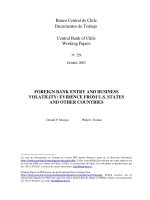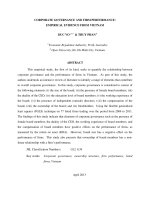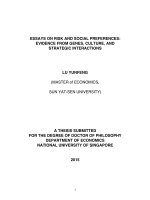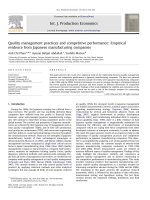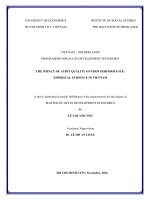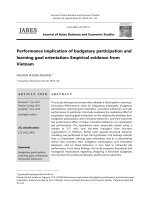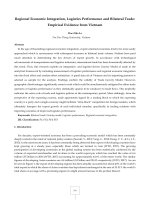Diversification strategies, bank risk and performance empirical evidence from vietnam
Bạn đang xem bản rút gọn của tài liệu. Xem và tải ngay bản đầy đủ của tài liệu tại đây (1.02 MB, 189 trang )
MINISTRY OF EDUCATION AND TRAINING
UNIVERSITY OF ECONOMICS HO CHI MINH
CITY
---------------------------
PHAM KHANH DUY
DIVERSIFICATION STRATEGIES,
BANK RISK AND PERFORMANCE:
EMPIRICAL EVIDENCE FROM VIETNAM
Major: Finance and Banking
Code: 9340201
DOCTORAL DISSERTATION
ACADEMIC ADVISOR:
Assoc. Professor Dr. TRUONG THI HONG
Ho Chi Minh City - 2021
ii
STATEMENT OF AUTHENTICATION
I solemnly declare that this dissertation, “Diversification strategies, bank risk and
performance: Empirical evidence from Vietnam”, is my own research.
Except for the references cited in this dissertation, I hereby guarantee that the
whole or any part of this dissertation has never been published or used to obtain
a degree elsewhere.
Any products/studies of other authors that have been used in this dissertation
were properly cited.
This dissertation has never been submitted to any university or institution.
Ho Chi Minh City, 2021
ACKNOWLEDGEMENT
In completing this dissertation, I would like to express my gratitude to the
University of Economics Ho Chi Minh City (UEH), which provides an ideal
environment and financial support for my research journey. At UEH, I have
gained valuable academic knowledge and research skills as a lecturer and as a
Ph.D. candidate.
My utmost appreciation is to my academic supervisor, Assoc. Prof. Dr. Truong
Thi Hong, for dedicated, whole-heartedly coaching and guidance throughout the
completion of my thesis.
My gratitude also goes to my dearest colleagues at the School of Banking and the
School of UEH Graduate for their continuously dedicated support, contributions,
and guidance, for me in writing this dissertation.
I want to thank Prof. Vo Xuan Vinh for the preliminary research ideas and
suggestions. My special thanks to Dr. Nguyen Huu Huan, Dr. Ngo Minh Vu, Dr.
Phan Chung Thuy, Dr. Hoang Hai Yen, and Dr. Ngo Minh Hai for their best
efforts in helping me with various challenges during my Ph.D. candidature.
Saying thank you is just simply not enough for what they have offered me.
Finally and most importantly, my beloved family and best friends have always
been by my sides, with unconditional love, encouragement, and endless support.
Without them, this dissertation would have never been written. Thank you all for
the most profound appreciation.
Ho Chi Minh City, October 2021
Pham Khanh Duy
TABLE OF CONTENTS
STATEMENT OF AUTHENTICATION........................................................... i
ACKNOWLEDGEMENT.................................................................................. ii
TABLE OF CONTENTS................................................................................... iii
ABBREVIATION LIST................................................................................... vii
LIST OF TABLES........................................................................................... viii
LIST OF FIGURES........................................................................................... ix
ABSTRACT......................................................................................................... x
TÓM TẮT.......................................................................................................... xi
CHAPTER 1 INTRODUCTION....................................................................... 1
1.1. Research motivation................................................................................ 1
1.2. Research background............................................................................... 8
1.3. Research gap identification.................................................................... 11
1.4. Research objectives............................................................................... 12
1.5. Research questions................................................................................ 14
1.6. The scope of research............................................................................ 15
1.7. Research procedure and methodology................................................... 15
1.8. Research contributions.......................................................................... 17
1.9. Structure of the dissertation................................................................... 19
CHAPTER 2 LITERATURE REVIEW AND HYPOTHESES
DEVELOPMENT............................................................................................. 22
2.1. Bank diversification definition................................................................. 22
2.2. Classification of bank diversification strategies....................................... 24
2.2.1. Asset diversification in the banking sector........................................ 28
2.2.2. Income diversification in the banking sector..................................... 30
2.2.3. Funding diversification in the banking sector.................................... 32
2.3. Theories of bank diversification............................................................... 35
2.3.1. Theories of diversification................................................................. 35
2.3.2. Theories of bank diversification........................................................ 40
2.4. Concept and measurement of bank risk and performance........................43
2.4.1. Concept and measurement of bank risk............................................. 43
2.4.2. Concept and measurement of bank performance...............................46
2.5. Theoretical overview of banking crisis..................................................... 47
2.6. The impact of diversification on bank risk and performance....................50
Although the concern on the impact of diversification on banks' risks and
performance is discussed in various articles, the conclusion of this topic is still
unclear............................................................................................................. 50
2.6.1. Asset diversification, bank risk, and performance.............................52
2.6.2. Income diversification, bank risk, and performance..........................56
2.6.3. Funding diversification, bank risk, and performance.........................60
2.6.4. Combinations of diversification strategies......................................... 61
2.6.5. Bank diversification, risk and performance in the financial crisis.....62
2.6.6. Role of ownership structure in the nexus between diversification, risk
and performance................................................................................ 64
2.7. Summary.................................................................................................. 67
CHAPTER 3 DATA AND METHODOLOGY............................................... 68
3.1. Data sample.............................................................................................. 68
3.2. Construction of variables.......................................................................... 70
3.2.1. Dependent variables – Bank risk and performance............................70
3.2.2. Key explanatory variables - Bank diversification measures...............72
3.2.3. Control variables................................................................................ 74
3.2.5. The role of financial distress and bank ownership............................. 76
3.3. Econometric models................................................................................. 79
3.4. Robustness check..................................................................................... 83
3.5. Conclusion............................................................................................... 86
CHAPTER 4 EMPIRICAL RESULTS AND DISCUSSION........................87
4.1. Descriptive statistics................................................................................. 87
4.2. Correlation matrix.................................................................................... 89
4.3. Empirical results....................................................................................... 91
4.3.1. Diversification strategies, bank’s risk and performance.....................91
4.3.2. Diversification strategy combination, bank risk and performance...102
4.3.3. Diversification, bank risk and performance during the crisis...........105
4.3.4. The role of bank ownership structure.............................................. 109
4.4. Robustness check results........................................................................ 117
4.5. Conclusion.............................................................................................. 117
CHAPTER 5 CONCLUSION........................................................................ 118
5.1. Summary of research findings................................................................ 118
5.2. Contributions.......................................................................................... 119
5.3. Policy implications................................................................................. 120
5.4. Limitations............................................................................................. 122
LIST OF PUBLICATION................................................................................... i
REFERENCES................................................................................................... ii
APPENDIX........................................................................................................ xv
ABBREVIATION LIST
ASEAN
Association of Southeast Asian Nations
BSI
The banking stability index
CPI
Consumer Price Index
DEA
Data envelopment analysis
FOB
Foreign-owned bank
GDP
Gross domestic product
GMM
Generalized Method of Moments
HHI
Herfindahl-Hirschman Index
JPoD
Joint Probability of Distress
JSB
Joint-stock bank
NIM
Net Interest Margin
NPL
Non-performing Loan
PB
Policy Bank
POLS
Pooled Ordinary Least Squared
RBV
Resources Based View
SBV
State Bank of Vietnam
SGMM
System Generalized Method of Moments
SOB
State-owned Bank
US
The United States of America
WTO
World Trade Organisation
LIST OF TABLES
Table 1.1: Descriptive number of banks in Vietnam, 2005-2019..........................5
Table 2.1: Summary of hypotheses associated with research questions..............66
Table 3.1: Definition of Variables....................................................................... 78
Table 3.2: The expected sign of variables........................................................... 79
Table 3.3: Testing steps for the hypotheses associated with the research question
..............................................................................................................................
85
Table 4.1: Summary statistics of variables.......................................................... 88
Table 4.2: Cross-Correlation Matrix of Variables............................................... 90
Table 4.3: Empirical results – Using Pooled OLS estimation Method Basic
model of the impact of diversification on banks performance and risks.............94
Table 4.4: Empirical results – Using Random effects estimation Method Basic
model of the impact of diversification on banks performance and risks.............96
Table 4.5: Empirical results – Using Fixed effects estimation approach Basic
model of the impact of diversification on banks performance and risks.............98
Table 4.6: Empirical results – Using SGMM estimation approach The baseline
model of the effectiveness of diversification strategies on banks performance and
risks................................................................................................................... 100
Table 4.7: Empirical Results Using SGMM Estimation Approach...................103
Table 4.8: Empirical results Using SGMM Estimation Approach.................... 107
Table 4.9: Regression Results Using SGMM Estimation Approach.................111
Table 4.10: Regression Results Using SGMM Estimation Approach
Diversification, risk and performance of Foreign banks................................... 113
Table 4.11: Robustness test results.................................................................... 115
LIST OF FIGURES
Figure 1.1: Diversification indexes of the Vietnam banks from 2005 to 2019......7
Figure 1.2: Research procedures........................................................................ 17
Figure 2.1: Research conceptual model.............................................................. 67
ABSTRACT
Purpose – This dissertation investigates the impacts of asset, funding, and
income diversification strategies and their combinations on the banking system’s
performance and risk in Vietnam, especially during the financial crisis. The
research also evaluates the role of ownership structure upon diversification-risk
and performance nexus.
Methodology – Using panel data collected from 34 Vietnamese commercial
banks from 2005 to 2019, with modern econometrics technique – two-step
system GMM estimator method described by Arellano and Bover (1995), are
employed to achieve research objectives. The data was collected manually from
the bank's audited financial statements, obtained from reliable sources.
Findings – The empirical results indicate that, in general, diversification
practices in banking sectors are effective in improving banks’ risk-return profile,
especially during the financial crisis. However, using them in combinations is
only effective for income and funding diversifications. These results are robust
regarding the use of alternative measures of diversification level. The results also
indicate that this impact varies across different types of bank ownership: Stateowned banks, domestic private banks, and foreign banks.
Contribution – This dissertation fills the gap in empirical literature by
systematically examining the nexus between diversification strategies, bank risk,
and performance, conditioned upon financial crisis and ownership structure. In
this sense, the findings of this dissertation provide bank managers and regulators
important information about the diversification strategy effectiveness to maintain
the stability of the banking system and financial market.
Keywords: Diversification strategies, bank performance, bank risk,
ownership structure, financial crisis, emerging market.
TĨM TẮT
Mục đích - Mục đích của luận án này là nghiên cứu tác động của các chiến lược
đa dạng hóa tài sản, nguồn vốn, thu nhập và sự kết hợp của chúng đối với rủi ro
và hiệu quả hoạt động của các ngân hàng thương mại Việt Nam, đặc biệt trong
thời kỳ khủng hoảng ngân hàng Việt Nam. Nghiên cứu cũng đánh giá vai trò của
cấu trúc sở hữu dựa trên mối quan hệ giữa đa dạng hóa-rủi ro và hiệu suất.
Phương pháp luận - Sử dụng dữ liệu bảng thu thập từ 34 ngân hàng thương mại
Việt Nam từ năm 2005 đến năm 2019, với kỹ thuật kinh tế lượng hiện đại phương pháp ước lượng GMM hệ thống hai bước được mô tả bởi Arellano và
Bover (1995), được sử dụng để đạt được các mục tiêu nghiên cứu. Dữ liệu được
thu thập theo cách thủ công từ báo cáo tài chính hàng năm của ngân hàng, lấy từ
Bankscope.
Kết quả - Kết quả thực nghiệm cho thấy, nhìn chung, thực tiễn đa dạng hóa
trong các lĩnh vực ngân hàng có hiệu quả trong việc cải thiện hiệu quả và rủi ro
của các ngân hàng, đặc biệt là trong cuộc khủng hoảng ngân hàng Việt Nam từ
năm 2011 đến năm 2014. Tuy nhiên, sử dụng kết hợp các chiến lược chỉ có hiệu
quả đối với đa dạng hóa thu nhập và đa dạng hóa nguồn vốn. Những kết quả này
rất rõ ràng khi sử dụng các phương pháp đo lường mức độ đa dạng hóa khác
nhau. Kết quả cũng chỉ ra rằng tác động này khác nhau giữa các loại hình sở hữu
ngân hàng: ngân hàng quốc doanh, ngân hàng tư nhân trong nước và ngân hàng
nước ngồi.
Đóng góp - Luận án này đóng góp thêm vào các nghiên cứu thực nghiệm bằng
cách xem xét một cách có hệ thống mối quan hệ giữa đa dạng hóa, rủi ro và hiệu
quả hoạt động ngân hàng, tùy thuộc vào cấu trúc sở hữu và trong từng thời kỳ.
Kết quả nghiên cứu của luận án cung cấp cho các nhà quản lý ngân hàng những
thông tin quan trọng về hiệu quả của chiến lược đa dạng hóa nhằm duy trì sự ổn
định của hệ thống ngân hàng và thị trường tài chính.
13
CHAPTER 1
INTRODUCTION
1.1.
Research motivation
“In
1952,
Nobel
Laureate
Harry
Markowitz
demonstrated
mathematically why putting all your eggs in one basket is an
unacceptably risky strategy and why diversification is the nearest an
investor or business manager can ever come to a free lunch. That
revelation touched off the intellectual movement that revolutionized
Wall Street, corporate finance and business decisions around the
world; its effects are still being felt today” Bernstein and Bernstein
(1996)
The practice of diversification has created conflicting arguments about its impact
on the banking sector’s risk and performance. On the one hand, a diversification
strategy is motivated by certain advantages that focused banks cannot have: (1)
gaining from exploiting managerial skills and abilities across products and
geographical areas (Iskandar-Datta & McLaughlin, 2007), (2) taking advantage
of economies of scale by sharing fixed costs across various products and markets
(Drucker & Puri, 2009), and (3) offering a wide range of financial services to
clients who require multiple products.
On the other hand, the ones that prefer the concentration strategy claim that
diversified banks can reduce their comparative management advantage when
investing in many areas they are not experts (Klein & Saidenberg, 1998).
Furthermore, diversification increases competition (Winton, 1999) and creates
higher agency costs resulting from diminishing value activities when managers
reduce their risk (L. Laeven & Levine, 2007).
The empirical literature on banking diversification first addresses developed
markets, where banks have been fully mature, such as the US market and other
developed countries in Europe (Baele, De Jonghe, & Vander Vennet, 2007; Curi,
Lozano-Vivas, & Zelenyuk, 2015; Elsas, Hackethal, & Holzhäuser, 2010;
Mercieca, Schaeck, & Wolfe, 2007; Stiroh & Rumble, 2006). The research and
discussion on this topic in emerging and transition economies are explored (N.
Chen, Liang, & Yu, 2018; Moudud-Ul-Huq, Ashraf, Gupta, & Zheng, 2018).
However, the literature provides different results for different countries and
regions (T. L. A. Nguyen, 2018). According to Doumpos, Gaganis, and Pasiouras
(2016), diversification can be more beneficial for banks operating in less
developed countries compared to banks in advanced and major advanced
countries.
Vietnam is one of the fastest-growing emerging markets with significant reforms
in both politics and the economy. Nevertheless, Vietnam is still considered a
special case study as the country still set itself as a market-driven economy under
a socialist regime (Doan, Lin, & Doong, 2018). State-owned enterprises play an
exclusive role in the economy, particularly the banking and financial system. The
banking sector is always one of the most important factors of all economic
systems. In Vietnam, the role of banks is more critical. The Vietnamese financial
system has been bank-based, in which the banking industry is considered the
bloodstream of the economy (Luu, Nguyen, & Vu, 2019; Vo & Nguyen, 2018).
Banks are the main source of short and long-term funding for almost all firms,
especially private firms (Tran, Ong, & Weldon, 2015). Typically, the banking
system in Vietnam is primarily dominated by State-owned commercial banks 1, of
which the majority shareholder is the State bank of Vietnam, with over 70% of
owner
equity.
Besides,
State-owned
commercial
banks
account
for
approximately 50% of the market shares, possessing a large customer base, make
them less motivated to improve their profitability or efficiency. The core
business of
1
There are four biggest State-owned commercial banks, including Vietnam Bank for Agriculture and Rural
Development, Joint Stock Commercial Bank for Investment and Development of Vietnam, Vietnam Joint Stock
Commercial Bank of Industry and Trade, and Joint Stock Commercial Bank for Foreign Trade of Vietnam.
Vietnamese banks was concentrated in traditional interest-bearing activities and
interbank lending. During the integration phase, especially in 2007, the
participation of Vietnam in the World Trade Organization (WTO) and the
penetration of 5 foreign banks’ wholly-owned subsidiaries resulted in fierce
competition in lending and deposit markets. Consequently, Vietnamese banks are
forced to step out of their traditional business models and gradually diversify
towards non-traditional activities (Le, 2015; P. A. Nguyen & Simioni, 2015).
When the real estate bubble burst in the United States in 2008, the Global
economy witnessed a subprime mortgage crisis followed by the global financial
crisis (Y. Chen, Wei, Zhang, & Shi, 2013; Demyanyk & Van Hemert, 2009). The
world economic growth slowed down while inflationary pressure still increased
considerably, challenging central banks' monetary policy. The degree of impact
was different depending on the level of integration into the economy. Many
economies, especially large economies like the US, Europe, and Japan, suffer
severe consequences such as negative economic growth, production and business
recall, bankruptcy, and unemployment... The financial market has continuously
shown negative signals in this condition, creating negative sentiment for the
market and the economy. The underlying cause of this economic catastrophe lies
in the credit crunch and the concentration risk in the bank’s credit portfolio.
Vietnam was not out of this negative trend. The effects of the global financial
crisis on the Vietnamese economy were not so small: limited production and
business activities; the value of industrial production has fallen; increase in
unemployment and problems with the credit relationship between banks and
customers (due to difficulties in the production and consumption of products by
companies...). The country has observed a dramatic downturn in all economic
indicators since 2009 and became worse in 2011-2014. GDP growth dropped to
4.8% in 2011, the lowest level since 1999, while the inflation rate continuously
rocketed out of control, with
double-digit inflation since the end of 2010. Moreover, total investment (mostly
from the state sector) decreased from around 40% GDP to around 30% GDP in
2011 - 2014 (ADB, 2014). The real estate prices depressed, fueled by sharp
increases in the real interest rate and a slowdown in capital flows. Vietnam's
economy faced a high trade deficit, and close-to-threshold budget deficit, and
public debt.
The Vietnamese financial market and banking industry suffered heavily from these
conditions. The slowdown trend in credit growth, sharp increases in nonperforming loans, and the rise of bad loans were the clear signs that had a
significant impact on the activities of commercial banks. Bad loans, lack of
liquidity, and poor performance were the main concerns for the entire industry.
The Vietnamese bank managers showed several weaknesses, including a lack of
capital buffer, poor management skills, and an efficient risk management
strategy. The rapid credit expansion without sufficient control of credit and
ethnic risk after the Global Financial Crisis (GFC) in 2008–2009 of economic
stimulus measures created the asset and credit quality problem for most
Vietnamese commercial banks. It was the underlying cause of Vietnam's banking
and financial distress from 2011 to 2014 (Do, Nguyen, & Le, 2017). During the
credit boom period, due to the concentration risk in the bank’s credit portfolio,
the contagion risk within the Vietnamese banking system is also considerably
concerned (P. H. Nguyen & Pham, 2020). As a result, the average nonperforming loans to total bank capital in the banking system spiked from under
5% in 2011 to nearly 12% in 2012 and about 15% in 2014, according to Fitch
Ratings and Moody’s Investor service estimations (Bank, 2014; Sugiyarto,
2015). The number of banks reduced from 52 in 2011 to 43 in 2015 (see Table
1.1) because of many insolvency cases and mergers & acquisitions. A dozen of
weak banks were eliminated.
In this context, to rescue the whole system out of this challenging situation, the
Vietnamese government has decided on a program to restructure the entire banking
industry, which was implemented from 2011 to 2015 (Huynh, Nasir, Nguyen, &
Duong, 2020; D. P. Nguyen, Ho, & Vo, 2018). Under this program, commercial
banks must improve asset quality and gradually diversify their activities into
non- credit services instead of relying on credit activities as per Prime Minister
Decision No. 254/QD-TTg dated 1 March 2012. Further, since 2016, the State
Bank of Vietnam has started requiring the implementation of Basel II, under
which there are five classes of assets: corporate, sovereign, bank, retail, and
equity (and then sub-classes) (State Bank of Vietnam, 2019). Following the
instructions of the Vietnamese government, the banks are starting to carry out
more diversification strategies to reconstruct their assets, liabilities, and income
quality.
Table 1.1: Descriptive number of banks in Vietnam, 2005-2019
2002
2005
2007
2011
2013
2015
2017
2019
State-owned
5
5
5
5
5
7
4
5
banks2
Joint-stock
39
37
37
37
33
28
31
31
commercial bank
Banks with 100%
5
5
5
5
5
5
8
9
foreign capital
Joint-venture
4
4
5
5
4
3
2
4
bank
Total
53
51
52
52
47
43
45
49
Source: State Bank of Vietnam, System of Credit Institutions, 2020
Depending on the current strength and resources, the bank can select various
diversification strategies regarding assets, funding, income. The bank uses its
resources to expand and diversify its business activities into one or more
different
2
Note: State-owned commercial banks are banks owned by State Bank of Vietnam, as regulated in the new Corporate
Law 2015.
areas to limit and disperse risks and increase revenue. The ultimate goal is to
increase profits in the relationship between risk control and bank profitability.
Conflicting regulations and supervision sometimes prompt the implementation
by banks of a diversification or concentration strategy. For example, banks often
remain focused due to branch, entry, and investment restrictions. However, some
banks may adopt a diversification strategy when their management boards put
risk reduction as a high priority.
We can also observe the switch from interbank lending before the turmoil and
sovereign debt during the 2012 recession to the new trend of consumer loan
concentration in recent years (Bezemer & Schuster, 2014). Besides, Vietnamese
commercial banks started to divest from different non-core business activities as
presented by the decreasing trend in the asset diversification index from 2011 to
2019 (see Figure 1.1). On the other hand, Vietnamese banks increasingly
employed diversification strategies for funding sources and income generations,
especially during the financial distress period, from 2011 to 2014. They offer
more fee-based services such as payment services, card payments, digital
banking, etc. Along with these changes, the bank thinks more about investing,
trading, insurance, and other non-interest products. Also, in retail banking, which
has recently developed, several fee-based products are being introduced in the
attachment. We call this the growth of the Vietnamese banking industry
(Bezemer & Schuster, 2016).
However, this trend towards diversification appears to be a double-edged sword.
The skyrocketing of several types of bank fees has sparked negative thoughts
about banking. Customers pose several questions about the bank’s transparency.
The bank provides several explanations, such as the costs of investment in
infrastructure and research and development for more innovative services and
products. But concerns remain. To calm the public, the State Bank of Vietnam
has
proposed restrictions on fee adjustments to avoid excessive fee increases (Bezemer
& Schuster, 2014). Conversely, however, the crucial concern of banks and
policymakers is whether this move slows down banks' performance. Evidence of
failure by managers and bank supervisors has set a problem that must be
reconsidered: the nexus between bank diversification, risk, and performance.
Figure 1.1: Diversification indexes of the Vietnam banks from 2005 to 2019
Funding diversification
Income diversification
Asset diversification
0.8000
0.5000
0.7500
0.4500
0.4000
0.7000
0.3500
0.3000
0.6500
0.2500
0.6000
0.2000
0.1500
0.5500
0.1000
0.5000
0.4500
0.0500
2005 2006 2007 2008 2009 2010 2011 2012 2013 2014 2015 2016 2017 2018 2019
-
Source: Own calculation
Should banks diversify or focus on those businesses they are familiar with? This
question has been attractive to both academics and economists over the past
decades. The decision to diversify or focus is discussed at length in the corporate
finance literature (Ramanujam & Varadarajan, 1989). However, a conclusion on
which strategy is better has not yet been reached.
Based on the above motivation, we come to the research problem:
After the financial distress and bank restructuring period from 2011
to 2014, Vietnamese banks are reforming to focus more on improving
assets, liabilities, and income quality using different diversification
strategies. However, the unique characteristics of the Vietnamese
banking system post the question about the effectiveness of
diversification
strategies
in
improving
Vietnamese
banks’
performance and risks. Therefore, this dissertation would like to
address this problem and contribute to the reforming process of the
Vietnamese banking system.
1.2.
Research background
Having a look at some economic theories, we found some mixed points of view.
According to modern portfolio theory, diversification is seen as a solution to
solve specific risks. In general, as an old saying goes, "do not put all eggs in a
basket," diversification consists of building a portfolio that includes several
investments to reduce risk (Fama & Jensen, 1985). Diversification by trying
different non- correlated activities, such as interest and non-interest, can benefit
banks and eliminate the risk. Banks that operate a large percentage of noninterest activities as a source of income will experience fewer fluctuations in
income (Tabak, Fazio, & Cajueiro, 2011; Winton, 1999). This view is consistent
with the modern investment theory (Haugen & Haugen, 2001), which believes
that banks can share their resources with multiple sectors and avoid the risk
of bank failures by diversifying.
However, based on agency problem theory, diversification can cause more
agency problems, raising agency costs and potential opportunity costs. When
managers are overconfident, they can make lousy diversification decisions,
which can cause instability in bank performance (Jensen, 1986; Jensen &
Meckling, 1976; Montgomery, 1994). Further, because the bank is unique and
different from other companies, a promising finding in the general corporate
finance literature may not be correct in the banking industry.
In addition, despite several articles examining the impact of banking
diversification and its performance, the scholars have not yet reached a general
agreement because the empirical results report conflicting conclusions. On the
one hand, the motivation of diversification strategy is certain advantages that
focused banks cannot have: (1) the gain arising from the exploitation of
managerial skills and abilities across products and geographical areas (IskandarDatta & McLaughlin, 2007), (2) take advantage of economies of scale by sharing
fixed costs across various products and markets (Drucker & Puri, 2009), and (3)
offering a wide range of financial services to clients who require multiple
products. On the other hand, the ones who prefer the concentration strategy claim
that diversified banks can reduce their comparative management advantage when
investing in many areas in which they are not experts (Klein & Saidenberg,
1998). Furthermore, diversification increases competition (Winton, 1999) and
creates higher agency costs resulting from activities of diminishing value when
managers want to reduce their risk (Amihud & Lev, 1981; L. Laeven & Levine,
2007).
Before 2010, the empirical literature on banking diversification was mainly
conducted in developed markets where banks were fully mature such as the US
and Europe (V. V. Acharya, Hasan, & Saunders, 2006; Curi et al., 2015; Elsas et
al., 2010; Mercieca et al., 2007; Rossi, Schwaiger, & Winkler, 2009; Stiroh &
Rumble, 2006; Yang, Liu, & Chou, 2020). However, the amount of research and
discussion on this topic in emerging and transition economies is much less, apart
from a few articles such as Odesanmi and Wolfe (2007), A. N. Berger, Hasan,
and Zhou (2010).
In the recent decade, many researchers investigating the relationship between
diversification and bank risk and performance seem to have a common interest in
developing and emerging markets. In Asia, where many developing countries are
concentrated, some authors conducted their research for groups of developing
countries (N. Chen et al., 2018; Moudud-Ul-Huq et al., 2018). Some others
approach this topic within a single country, such as Brazil (Tabak et al., 2011),
China (A. N. Berger, Hasan, & Zhou, 2010), the Philippines (Meslier, Tacneng,
& Tarazi, 2014), Ghana (Duho, Onumah, & Owodo, 2019), or Vietnam (Batten
& Vo, 2016; Y. Chen et al., 2013; Luu et al., 2019; Vo, 2017). This topic has
never run out of heat for scientific researchers and managers all over the world.
However, inferring from various empirical research, the diversity strategy
performs differently in different countries. The diversified structure gives more
advantages for banks in less developed areas; meanwhile, its benefit on banks in
developed countries is not significant (Doumpos et al., 2016). Moreover, the
effects of diversification in a bank-based economy like Vietnam and marketbased economies may be much different (Mirzaei & Kutan, 2016).
In Vietnam mainly, the practice so far has created conflicting arguments about
the impact of diversification on the risk and performance of the banking
business. This creates doubts and uncertainties about the benefits of
diversification. Since then, there has been a great interest among researchers and
policymakers. Typically, some previous researchers focused on asset, income,
and funding diversifications in the Vietnam banking system but amongst a group
of 5 to 6 Asian countries (Moudud-Ul-Huq et al., 2018; T. L. A. Nguyen, 2018).
They report that banks with greater foreign-owned asset diversification have
greater profit efficiency, but this diversification only helps banks grow instantly
but lacks long-term efficiency. Some authors see diversification as a significant
way to avoid risks for Vietnamese banks. Moreover, higher funding
diversification will remarkably increase Vietnamese banks' profitability (Batten
& Vo, 2016).
Others approach banking diversification through investor insights (Vo, 2017); or
focus on the contribution of funding liquidity diversification to bank risk and
performance (Vo, 2020). The research found that funding diversification can help
banks improve their profitability, but higher diversification tends to take more
risky decisions (Vo, 2018). However, in most of these studies, authors separately
put their interest on revenue diversification or funding separately, and researches
on asset diversification are scarce. Also, to the best of my knowledge, previous
researches do not systematically examine the impact of diversification strategies
on bank risk and return during financial distress, nor investigate the effects of a
combination of diversification strategies on banks, to offer bankers the optimal
diversification portfolio models for specific periods.
1.3.
Research gap identification
In the novel of theory and practice, this research contributes to the existing
literature by filling the gaps: bank diversification, risk, and performance
literature in Vietnam. An interesting research question is: whether diversification
strategies effectively affect the Vietnamese banks’ performance and risk,
especially in the banking crisis period? More importantly, in practice, banks need
to deal with all three diversification strategies simultaneously. Thus, it is
interesting to investigate the question of how banks can combine these three
diversification strategies to achieve their expected risk-return objectives.
Firstly, this dissertation presents how Vietnamese diversified banks differ from
concentrated ones in terms of risk and return in the period from 2005 to 2019.
Research on one country separately, instead of a group of countries, is considered
necessary because of different country’s unique characteristics in terms of
economics and politics. A fifteen-year period of time is quite efficient for most
econometric models, which is why this dissertation uses the period from 20052019. Moreover, banking data are not adequate before 2005, with many missing
figures.
Secondly, the whole sample period covers the Vietnamese banking distress
period from 2011 to 2014, so this dissertation systematically examines how
diversification impacts risk and performance during the distress. Dziobek and
Pazarbasioglu (1998), investigating the governmental reaction policies on the
crisis in 24 countries (including developing, developed, and transition
economics), documented 13 kinds of policy used to respond to the crisis. Among
these policies, four can help identify the Vietnamese banking and financial crisis
from 2005 to 2019: Liquidity intervention from the government, central bank;
Establishment of nonperforming-loan management unit; Taking over the crisis
bank; Consolidation of crisis banks.
Thirdly, this dissertation investigates whether the relationship between
diversification and bank performance and risk is conditioned upon different bank
ownership types. While scanning previous literature reviews on this topic, we
find no research on the effects of multiple diversity strategies on Vietnamese
banking risk and performance. In addition, no author previously has questioned
if this relationship would vary in different banks with different ownership
structures. Therefore, the case of Vietnam attracts our interest to examine the
linkage between banking diversity, bank risk, and performance.
The following subsections present the objectives and questions of this dissertation.
1.4.
Research objectives
Diversification is usually seen as a strategy to improve bank risk and
performance until the recent financial chaos, which has raised many concerns
about this claim. Despite the growing number of empirical studies on the
relationship between diversification strategy and banks' profitability, researchers
have not yet been able to find a general agreement. One of the reasons is that the
results for each country are different from the others. The well-founded evidence
is mixed between
countries and regions. In particular, regarding asset, income, and funding
diversification measures, the conclusions are mixed on the impact on banks'
performances and risks.
Based on previous studies in the diversification literature, the first objective of
this dissertation is to measure the level of bank diversifications and their impact
on the risk and performance of Vietnamese commercial banks in the period from
2005 to 2019. The characteristics of diversification strategies are deeply captured
in all three dimensions: assets, funding, and income. These three dimensions
cover both asset-liabilities sides in the balance sheet and the bank income
statement. Moreover, we examine the different effects of combining these three
diversification strategies to offer optimal diversification models for banks.
Secondly, this dissertation analyses how diversification could impact banking
risk and performance in Vietnam during the banking distress period (2011-2014),
to offer some practical suggestions for bank managers and prudential authorities
in emerging markets to adjust bank diversification strategy and monetary policy
to improve risk and financial performance of the banking system in the economic
turmoil period.
This dissertation's third objective is to systematically investigate the role of
ownership strategy, including state-owned banks and foreign bank’s owned
subsidiaries, on the nexus between diversification, risk, and performance.
This dissertation uses secondary data, quantitative methods, and econometric
models. The scope of research is the Vietnamese banking system, a frontier
economy. This dissertation could also be developed for further studies in the
same field.
